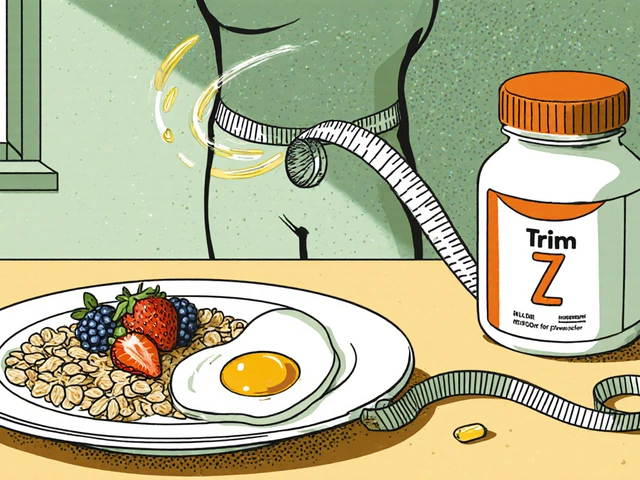RA Medication Timeline Calculator
Living with Rheumatoid arthritis is a daily balancing act between flare‑ups and moments of relief. The joint inflammation that defines RA can turn simple tasks-like opening a jar or typing an email-into painful episodes. The good news? A mix of smart medication choices, movement, diet tweaks, and mind‑body tools can dramatically shrink that pain‑scale. Below you’ll find a practical toolbox you can start using today.
Key Takeaways
- Identify the type of pain you’re dealing with-acute flare vs. chronic background-and target it with the right strategy.
- Use a layered medication plan: fast‑acting NSAIDs for flare‑ups, DMARDs for long‑term control, and biologics when disease is aggressive.
- Incorporate low‑impact exercise at least three times a week to maintain joint range and muscle strength.
- Adopt an anti‑inflammatory diet rich in omega‑3 fatty acids, antioxidants, and fiber.
- Practice stress‑reduction techniques (mindfulness, breathing, gentle yoga) to lower pain‑sensitizing inflammation.
What Drives RA Pain?
RA is an autoimmune disorder that triggers the immune system to attack synovial tissue. This leads to swelling, cartilage erosion, and bone damage-each a source of pain. Pain can be classified into two broad categories:
- Inflammatory pain: Sharp, throbbing, often worse in the morning or after inactivity. Driven by cytokines such as TNF‑α and IL‑6.
- Mechanical pain: Dull ache from joint damage, muscle fatigue, or altered gait.
Knowing which type dominates your experience helps you select the most effective tool from the toolbox.
Medication Toolbox
Pharmacologic relief remains the cornerstone of RA pain control. Below is a quick‑look at the three main classes, followed by a side‑by‑side comparison.
NSAIDs (non‑steroidal anti‑inflammatory drugs) act fast-within an hour-to blunt inflammation and provide temporary pain relief. Common choices include ibuprofen, naproxen, and low‑dose aspirin.
DMARDs (disease‑modifying antirheumatic drugs) target the underlying immune process. Conventional DMARDs like methotrexate, sulfasalazine, and leflunomide require weeks to months to show effect but can dramatically reduce flare frequency.
Biologics are engineered proteins that block specific cytokines (e.g., TNF‑α inhibitors such as etanercept, adalimumab). They are reserved for moderate‑to‑severe disease not controlled by DMARDs.
| Class | Typical Start Dose | Onset of Pain Relief | Key Side Effects |
|---|---|---|---|
| NSAIDs | Ibuprofen 400‑800mg q6‑8h | 30‑60minutes | Stomach irritation, kidney strain |
| Conventional DMARDs | Methotrexate 7.5‑25mg weekly | 4‑12weeks | Liver enzyme elevation, mouth sores |
| Biologics | Etanercept 50mg weekly (subcut) | 2‑4weeks | Infection risk, injection site reactions |
Tip: Pair a short‑acting NSAID for immediate flare relief with a DMARD or biologic for long‑term disease control. Always discuss dosing and monitoring with your rheumatologist.

Move to Ease the Ache
Exercise may feel counter‑intuitive when joints hurt, but staying active preserves joint function and releases endorphins that naturally dampen pain signals.
Physical therapy specialists design individualized programs that include:
- Range‑of‑motion (ROM) stretches to keep joints supple.
- Isometric strengthening-muscle activation without joint movement-to protect vulnerable joints.
- Low‑impact cardio (walking, swimming, cycling) to boost circulation.
For home‑based routines, try the following three‑day split:
- Day 1 - Upper Body: Wall push‑ups (2×10), seated rows with resistance band (2×12), gentle neck rotations (30seconds each side).
- Day 2 - Lower Body: Chair squats (2×10), heel raises (2×15), ankle circles (30seconds each direction).
- Day 3 - Mobility & Cardio: 15‑minute walk at a comfortable pace, followed by thoracic spine twists (2×8 each side) and deep breathing.
Start with low repetitions and gradually increase as pain permits. Consistency beats intensity.
Food as Medicine
Diet won’t replace medication, but certain foods can tone down the inflammatory cascade.
Anti‑inflammatory diet principles:
- Omega‑3 rich fish-salmon, sardines, mackerel (2 servings/week) lower TNF‑α.
- Colorful vegetables-leafy greens, berries, peppers supply antioxidants (vitamin C, polyphenols).
- Whole grains-oats, quinoa, brown rice provide fiber that supports gut microbiome balance.
- Avoid processed meats, excess sugar, and trans fats which can spike IL‑6 levels.
Sample breakfast: Greek yoghurt topped with flaxseed, blueberries, and a drizzle of honey. Lunch: Quinoa salad with kale, grilled salmon, and olive‑oil vinaigrette. These combos keep you satiated while delivering joint‑friendly nutrients.
Mind‑Body Strategies
Chronic pain amplifies stress, and stress fuels inflammation-a vicious loop. Breaking it with mental‑health tools can lower perceived pain by up to 30% (study from the University of Manchester, 2023).
Mindfulness meditation (5‑10minutes daily) trains the brain to observe pain without judgment, reducing the emotional weight of the sensation. Apps like Headspace or Insight Timer provide guided sessions.
Breathing exercises-4‑7‑8 method (inhale 4seconds, hold 7, exhale 8)-activate the parasympathetic nervous system, lowering cortisol and IL‑1β levels.
Gentle yoga flows, especially those emphasizing joint‑friendly poses (Cat‑Cow, Child’s pose, seated twists), improve flexibility and provide a built‑in meditation.

Everyday Lifestyle Tweaks
- Heat & Cold Therapy: Warm showers, heating pads, or warm olive‑oil wraps can ease stiff joints in the morning; ice packs (15minutes) reduce swelling after activity.
- Ergonomic Adjustments: Use cushioned mouse pads, keyboard trays, and supportive footwear to keep joints aligned.
- Sleep Hygiene: Aim for 7‑9hours of restful sleep. A firm mattress with a pillow that supports the neck reduces overnight joint strain.
- Weight Management: Extra pounds increase joint load, especially in knees and hips. Even modest weight loss (5‑10% of body weight) can lower pain scores by 20%.
When to Call Your Rheumatologist
Self‑management works well for mild‑to‑moderate pain, but certain red flags demand professional attention:
- Sudden, severe joint swelling that doesn’t improve with NSAIDs.
- Fever, unexplained weight loss, or night sweats.
- New neurologic symptoms-numbness, weakness, or vision changes.
- Inability to perform daily activities despite adherence to medication and lifestyle plan.
Early intervention with a rheumatologist can adjust therapy, add biologics, or suggest joint injections before irreversible damage occurs.
Quick Checklist for Daily Pain Management
- Take prescribed medication on schedule; keep a symptom log.
- Do a 10‑minute joint‑friendly stretch each morning.
- Include at least one omega‑3 serving in your meals.
- Practice 5‑minute mindfulness before bed.
- Apply heat to stiff joints for 10minutes; ice to swollen areas after activity.
Frequently Asked Questions
Can I stop taking NSAIDs once my DMARDs start working?
Most doctors advise tapering NSAIDs slowly rather than stopping abruptly, especially if you still experience occasional flares. Discuss a taper schedule with your rheumatologist to avoid rebound inflammation.
Is exercise safe during a flare?
Gentle range‑of‑motion movements and low‑impact cardio are generally safe. Avoid high‑impact or heavy‑load activities until swelling subsides. A physical therapist can tailor flare‑specific routines.
Do dietary supplements help with RA pain?
Omega‑3 fish oil (1‑3g EPA/DHA daily) has the strongest evidence for reducing joint tenderness. Curcumin and ginger show modest benefits, but quality varies. Always check with your doctor before adding supplements.
How often should I see my rheumatologist?
If your disease is stable, a 6‑month follow‑up is typical. During medication changes or flare‑ups, schedule visits every 1‑2months until stability returns.
Can stress really make my joints hurt more?
Yes. Stress elevates cortisol and pro‑inflammatory cytokines, which can amplify joint swelling and pain perception. Mind‑body practices that lower stress often translate into lower pain scores.








12 comments
Halle Redick
Hey folks, managing RA pain can feel like a never‑ending roller coaster, but you’ve got a solid toolbox right here.
Start by matching the type of pain-sharp inflammatory flares need fast‑acting NSAIDs, while the dull ache from joint wear calls for steady DMARDs or gentle movement.
A quick tip: keep a small notebook or phone note of which meds calm a flare and how long they last; patterns emerge fast.
Mix in low‑impact cardio like swimming or cycling-your joints will thank you with improved range and a natural endorphin boost.
Don’t underestimate the power of omega‑3 rich foods; a couple of salmon servings a week can actually dial down cytokine storms.
Warm showers in the morning and a brief ice pack after activity can keep stiffness and swelling in check.
Finally, a few minutes of mindfulness before bed can lower stress hormones that amplify pain.
Keep experimenting, stay consistent, and lean on your rheumatologist for tweaks-you’ve got this!
Max Canning
Kick that pain right out the door!
Nick Rogers
Indeed, the stratified approach to RA pain is essential.; NSAIDs provide rapid relief.; DMARDs target underlying pathology.; Biologics are reserved for refractory cases.; Consistent monitoring is paramount.;
Tesia Hardy
I hear you loud and clear-finding the right mix can be a real puzzle.
Try starting with a gentle morning stretch routine; even five minutes can make a big diff.
Don't forget to sip plenty of water when you take ibuprofen, it helps protect the stomach.
Also, keep an eye on your diet – the anti‑inflam food map is a lifesaver.
Just remember, every body reacts diffently, so be patient with yourself!
Matt Quirie
The patient is advised to maintain a regular schedule of medication administration; adherence has been shown to correlate with reduced flare frequency.; Additionally, incorporating low‑impact aerobic activity is recommended; this may enhance joint mobility and overall well‑being.;
Pat Davis
While adherence is undeniably crucial, it is equally important to address lifestyle factors such as ergonomics and nutrition; a comprehensive plan that integrates these elements will likely yield superior outcomes.;
Mary Wrobel
Imagine your joints as a garden-if you water them with the right nutrients and prune the weeds of inflammation, they’ll blossom beautifully.
Rich, oily fish are the sunshine, while leafy greens act as the fertile soil.
Swap out processed snacks for a handful of walnuts or a vibrant berry parfait, and you’ll feel the difference ripple through your limbs.
Pair this culinary palette with a splash of sunrise cardio-perhaps a breezy bike ride or a playful water‑aerobics class.
Consistency, not perfection, is the secret sauce; let each day be a fresh brushstroke on your canvas of comfort.
Michelle Guatato
Look, they don’t want you to know how simple it is-big pharma pushes those pricey biologics while the real cure lies in diet, sunlight, and movement, a fact they hide behind glossy ads and complex trial data.
They even mastermind the guidelines to keep us dependent on perpetual prescriptions, the very same ones that inflate their bottom line.
By re‑educating ourselves and sharing these overlooked tips, we can cut through the noise and reclaim autonomy over our pain.
Don’t let the system dictate your health; dig deeper, question the narratives, and trust the body’s innate wisdom.
Jenn Zee
It is both a privilege and a responsibility to navigate the labyrinthine landscape of rheumatoid arthritis therapeutics, for therein lies a confluence of biochemistry, immunology, and lived experience that demands a nuanced, evidence‑based approach.
First and foremost, the immediacy of inflammatory pain necessitates judicious use of non‑steroidal anti‑inflammatory drugs, which, when administered at the appropriate dosage, can attenuate prostaglandin synthesis within minutes, thereby restoring a semblance of functional capacity.
Concurrently, the long‑term suppression of aberrant immune activation is paramount; conventional disease‑modifying antirheumatic drugs, such as methotrexate, have demonstrable efficacy in reducing joint erosions over a period of weeks to months, yet they require vigilant monitoring of hepatic enzymes and hematologic parameters.
When patients exhibit inadequate response or intolerable side effects, the therapeutic algorithm gracefully escalates toward biologic agents that selectively antagonize cytokines like TNF‑α; these agents, while revolutionary, introduce a spectrum of infectious risks that must be balanced against their profound disease‑modifying potential.
Beyond pharmacology, the incorporation of structured, low‑impact aerobic exercise serves not merely as a palliative adjunct but as an essential stimulus for synovial fluid circulation and muscular fortification, thereby mitigating the mechanical stresses that exacerbate joint degradation.
Nutritional modulation, particularly the enrichment of the diet with omega‑3 fatty acids derived from marine sources, has been substantiated by meta‑analyses to attenuate systemic inflammation, as evidenced by reductions in C‑reactive protein and erythrocyte sedimentation rate.
Moreover, the psychosomatic interplay cannot be overstated; chronic pain invariably engenders heightened cortisol secretion, which in turn perpetuates a pro‑inflammatory milieu-mindfulness‑based stress reduction and diaphragmatic breathing have emerged as empirically validated strategies to disrupt this deleterious feedback loop.
Ergonomic optimization within the home and workplace, such as employing supportive seating and judicious keyboard positioning, alleviates undue joint strain, while meticulous sleep hygiene-characterized by a consistent circadian schedule and a supportive mattress-facilitates reparative processes during nocturnal rest.
It is incumbent upon the patient to maintain a detailed symptom diary, documenting pain intensity, functional limitations, and pharmacologic interventions, for such data empower both the patient and the rheumatologist to tailor therapeutic regimens with precision.
Regular interdisciplinary consultations, encompassing rheumatology, physical therapy, nutrition, and mental health, foster a holistic paradigm that transcends the reductionist focus on medication alone.
In scenarios of acute flare, judicious short‑course corticosteroids may be employed, yet clinicians must remain vigilant for potential iatrogenic sequelae, such as hyperglycemia and bone demineralization.
Conversely, during periods of remission, a strategic tapering of adjunctive therapies, under close supervision, can mitigate cumulative drug exposure while preserving disease control.
Finally, it is essential to recognize the heterogeneity of patient experiences; genetic polymorphisms, comorbidities, and sociocultural factors inexorably shape treatment responses, underscoring the necessity for personalized medicine.
In sum, mastery of rheumatoid arthritis pain management resides at the intersection of pharmacologic rigor, lifestyle optimization, and compassionate patient engagement, each element synergistically contributing to the overarching goal of sustained functional independence and quality of life.
Steph Hooton
Indeed, the comprehensive overview you provided underscores the necessity of an interdisciplinary approach; however, it is crucial to acknowledge that patient individuality may modulate the efficacy of each component mentioned.
While the evidence supporting omega‑3 supplementation is compelling, dosage optimization should be guided by periodic lipid profiling.
Furthermore, the integration of psychosocial interventions must be balanced against practical constraints such as insurance coverage and provider availability.
In summary, a nuanced, patient‑centered plan, regularly reassessed, will likely achieve the most sustainable pain mitigation.
Judson Voss
Let's be honest: many of the so‑called "miracle" diets and flashy exercises are just marketing fluff; without rigorous clinical validation they rarely deliver lasting relief.
Patients often latch onto anecdotal success stories, ignoring the fundamental need for evidence‑based pharmacotherapy.
While lifestyle modifications certainly have a role, they should complement-not replace-proper medical management under a qualified rheumatologist.
Otherwise, you risk wandering in a maze of contradictory advice that ultimately stalls progress.
Jessica Di Giannantonio
Amidst the noise, I find quiet strength in the simple rituals- a sunrise stretch, a mindful breath, a warm cup of herbal tea-that whisper hope into the chaotic storm of RA.
These gentle moments, though modest, weave a tapestry of resilience that carries me through each day.
Even when the pain roars, the calm within can soften its edge, reminding me that I am more than my joints.